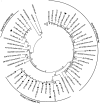Hepatitis E virus infection in central China reveals no evidence of cross-species transmission between human and swine in this area
- PMID: 19997619
- PMCID: PMC2785466
- DOI: 10.1371/journal.pone.0008156
Hepatitis E virus infection in central China reveals no evidence of cross-species transmission between human and swine in this area
Abstract
Hepatitis E virus (HEV) is a zoonotic pathogen of which several species of animal were reported as reservoirs. Swine stands out as the major reservoir for HEV infection in humans, as suggested by the close genetic relationship of swine and human virus. Since 2000, Genotype 4 HEV has become the dominant cause of hepatitis E disease in China. Recent reports showed that genotype 4 HEV is freely transmitted between humans and swine in eastern and southern China. However, the infection status of HEV in human and swine populations in central China is still unclear. This study was conducted in a rural area of central China, where there are many commercial swine farms. A total of 1476 serum and 554 fecal specimens were collected from the general human and swine populations in this area, respectively. The seroepidemiological study was conducted by enzyme-linked immunosorbent assay. Conserved genomic sequences of open reading frame 2 were detected using reverse transcription-PCR. The results indicated that the overall viral burden of the general human subjects was 0.95% (14/1476), while 7.0% (39/554) of the swine excreted HEV in stool. The positive rate of anti-HEV IgG and IgM in the serum samples was 7.9% (117/1476) and 1.6% (24/1476), respectively. Phylogenetic analysis based on the 150 nt partial sequence of the capsid protein gene showed that the 53 swine and human HEV isolates in the current study all belonged to genotype 4, clustering into three major groups. However, the HEV isolates prevalent in the human and swine populations were classified into known distinct subgenotypes, which suggested that no cross-species transmission between swine and humans had taken place in this area. This result was confirmed by cloning and phylogenetic analysis of the complete capsid protein gene sequence of three representative HEV strains in the three major groups. The cross reactivity between anti-HEV IgG from human sera and the two representative strains from swine in central China was confirmed by Dot-blot assay. In conclusion, although all the HEV strains prevalent in central China belonged to genotype 4, there is no evidence of cross-species transmission between human and swine in this area.
Conflict of interest statement
Figures



Similar articles
-
Seroprevalence and evolutionary dynamics of genotype 4 hepatitis E virus in Shandong Province, China.World J Gastroenterol. 2014 Jun 28;20(24):7955-63. doi: 10.3748/wjg.v20.i24.7955. World J Gastroenterol. 2014. PMID: 24976732 Free PMC article.
-
Prevalence of four different subgenotypes of genotype 4 hepatitis E virus among swine in the Shanghai area of China.Acta Vet Scand. 2008 May 31;50(1):12. doi: 10.1186/1751-0147-50-12. Acta Vet Scand. 2008. PMID: 18513433 Free PMC article.
-
[Phylogenetic analysis of hepatitis E virus strains isolated from both human and swine in Anqing City].Zhonghua Yu Fang Yi Xue Za Zhi. 2010 Oct;44(10):888-92. Zhonghua Yu Fang Yi Xue Za Zhi. 2010. PMID: 21176518 Chinese.
-
The Current Host Range of Hepatitis E Viruses.Viruses. 2019 May 17;11(5):452. doi: 10.3390/v11050452. Viruses. 2019. PMID: 31108942 Free PMC article. Review.
-
A review of hepatitis E virus.J Food Prot. 2001 Apr;64(4):572-86. doi: 10.4315/0362-028x-64.4.572. J Food Prot. 2001. PMID: 11307901 Review.
Cited by
-
Seasonal pattern of hepatitis E virus prevalence in swine in two different geographical areas of China.Epidemiol Infect. 2013 Nov;141(11):2403-9. doi: 10.1017/S0950268813000113. Epub 2013 Feb 6. Epidemiol Infect. 2013. PMID: 23388392 Free PMC article.
-
HEV-ORF3 Encoding Phosphoprotein Interacts With Hepsin.Hepat Mon. 2014 Jan 18;14(1):e13902. doi: 10.5812/hepatmon.13902. eCollection 2014 Jan. Hepat Mon. 2014. PMID: 24596579 Free PMC article.
-
Identification of genotype 4 Hepatitis E virus binding proteins on swine liver cells.Virol J. 2011 Oct 27;8:482. doi: 10.1186/1743-422X-8-482. Virol J. 2011. PMID: 22029540 Free PMC article.
-
Prevalence of hepatitis E virus and porcine caliciviruses in pig farms of Guizhou province, China.Hepat Mon. 2011 Jun;11(6):459-63. Hepat Mon. 2011. PMID: 22087178 Free PMC article.
-
Genotype 4 Hepatitis E Virus Prevalent in Eastern China Shows Diverse Subtypes.Hepat Mon. 2015 Jun 23;15(6):e25367. doi: 10.5812/hepatmon.25367v2. eCollection 2015 Jun. Hepat Mon. 2015. PMID: 26288632 Free PMC article.
References
-
- Reyes GR, Purdy MA, Kim JP, Luk KC, Young LM, et al. Isolation of a cDNA from the virus responsible for enterically transmitted non-A, non-B hepatitis. Science. 1990;247:1335–9. - PubMed
-
- Kamar N, Selves J, Mansuy JM, Ouezzani L, Péron JM, et al. Hepatitis E virus and chronic hepatitis in organ-transplant recipients. N Engl JMed. 2008;358:811–7. - PubMed
-
- Somani SK, Aggarwal R, Naik SR, Srivastava S, Naik S. A serological study of intrafamilial spread from patients with sporadic hepatitis E virus infection. J Viral Hepat. 2003;10:446–9. - PubMed
-
- Goens SD, Perdue ML. Hepatitis E viruses in humans and animals. Anim Health Res Rev. 2004;5:145–56. - PubMed
-
- Shukla P, Chauhan UK, Naik S, Anderson D, Aggarwal R. Hepatitis E virus infection among animals in northern India: an unlikely source of human disease. J Viral Hepat. 2007;14:310–7. - PubMed
Publication types
MeSH terms
Substances
LinkOut - more resources
Full Text Sources
Research Materials

